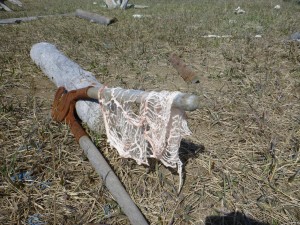Ruminant Anatomy
August 27 – September 16
When we are talking about a health or production issue with our veterinarian, co-worker, client or fellow producer we need to have a common reference point. Using standard anatomical terminology ensures that all of us have a common method of communicating to avoid confusion when talking about a diseased structure or organ. The most important thing is to develop a universal terminology. In this section your goal should be to learn and identify the structures and functions of the major systems of domestic animals. Some structures may be very familiar, but others, say the structures of ruminants may not. It is important to be able to identify the major cells, tissues, and organs and how they function as individual units and also as integrated organ systems. And each system depends on the others, either directly or indirectly, to keep the animal functioning normally. I have tried to use a number of different views so you can get three-dimensional feel for the structures of the animals.
Review, Review, Review
I can’t state it enough; review! there are a lot of structures to identify and terminology to memorize. For most of the modules to really comprehend the material, you must constantly review. It is vital that you read the material and listen to the lectures more than once. Be sure to always take practice quizzes before taking any test or quiz. Get together with a study group or social media and quiz each other on the material. The main thing you want to avoid is falling behind. With the volume of information that is covered in this course, it is important that you stay current.
Objectives
- Identify features of ungulate anatomy and physiology.
- Identify the organs and bones and muscles of ungulates.
| Instruction | 3 hrs |
| Assignments | 3 hrs |
| Collaboration | 2 hrs |
Learning Activity
Read pages 1-3 of The Reindeer Health Aide Manual.
The anatomy of a ruminant will be examined using the website
www.ucalgary.ca/caribou/CaribouAnatomy.html
Identify the following structures:
Skeleton
- Skull
- Atlas
- Axis
- Cervical vertebrae
- Scapula
- Thoracic vertebrae
- Lumbar vertebrae
- Pelvic bone
- Sacrum
- Caudal vertebrae
- Femur
- Tibia Fibula
- Metatarsus
- Phalanges
- Ribcage
- Humerus
- Radius Ulna
- Carpus
- Metacarpus
Organs: Identify
- Left Caudal Lobe of Lung
- Spleen
- Rumen
- Kidney
- Duodenum
- Greater Omentum
- Intestine
- Liver
- Diaphram
- Right Caudal Lobe of Lung
- Heart — Left Atrium
- Cranial Lobe of Right Lung
- Trachea
- Left Azygous Vein
- Left Bronchus
- Esophagus
- Aorta
- Accessory Lobe Right Lung
Muscles: Identify
- Biceps Brachii
- Pectoral Muscles
- Sternocephalicus
- Gluteobiceps
- Quadriceps
- Longissimus Muscle
- Trapezius
- Latissimus Dorsi
- Gluteus Medius
- Triceps
- External Oblique
- Tensor Fasciae Latae
- Illiocostalis Muscle
- Deltoideus
- External Intercostals
Quizzes
Due September 16 before midnight.
Skeletal Structure Identification Quiz
Take as long as you want for these quizzes, but remember they can be taken one time only.
Reflection and Writing
Due September 16 before midnight.
The meat and fat of reindeer are universally eaten. What other reindeer tissues and organs are eaten? How would you cook them? Head over to the forums for this week, answer these questions and provide a recipe. Discuss with your peers.

